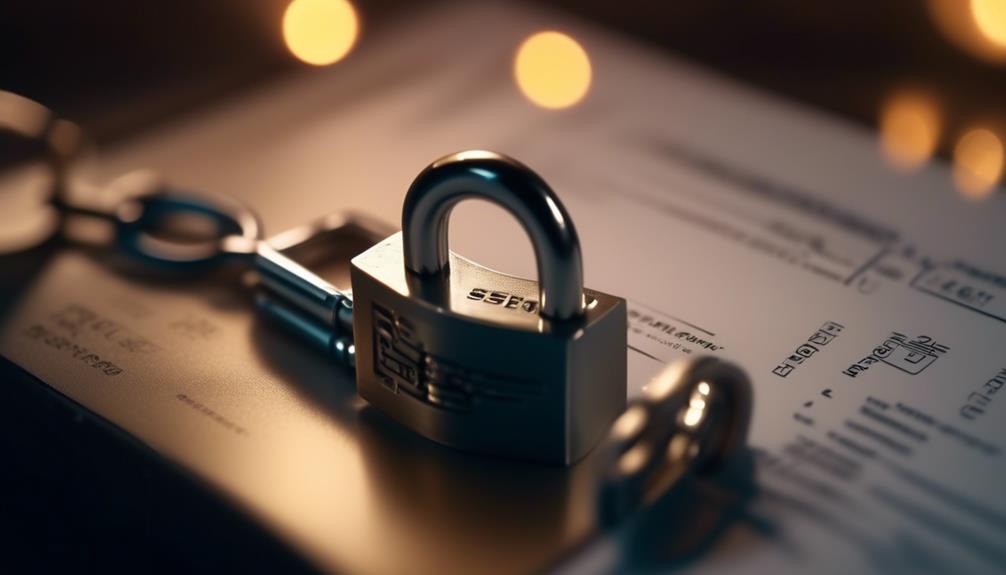So, you’ve decided to enter some form data. Exciting, right? Well, before you jump headfirst into the world of form submissions, it’s important to consider the security of your data. With cyber threats lurking at every corner, it’s crucial to take the necessary steps to protect your information. But fear not, dear reader, for in this discussion, we shall uncover the secrets of securing form data entry, leaving you with peace of mind and a sense of security.
Understand Data Security Measures
To ensure the safety of your form data, it is crucial to understand and implement effective data security measures. Data breach prevention and secure network protocols play a significant role in safeguarding your information.
Data breach prevention involves taking proactive steps to protect your form data from unauthorized access. This includes implementing strong authentication measures, such as multi-factor authentication, to ensure that only authorized individuals can access sensitive information. Additionally, regularly updating and patching your software and systems can help prevent vulnerabilities that could be exploited by hackers.
Secure network protocols are essential for securely transmitting form data over the internet. By using protocols such as HTTPS, which encrypts the data during transit, you can ensure that your information remains confidential and cannot be intercepted by malicious actors. It is also important to regularly monitor and audit your network for any suspicious activities or unauthorized access attempts.
Understanding and implementing these data security measures is crucial in protecting your form data from potential breaches. By staying vigilant and staying up to date with the latest security practices, you can minimize the risk of data breaches and safeguard your sensitive information.
Design Secure Form
When designing a secure form, it is important to implement encryption for data security. This ensures that sensitive information remains protected during transmission and storage. Additionally, incorporating user authentication measures adds an extra layer of security by verifying the identity of individuals accessing the form.
Encryption for Data Security
For enhanced data security, consider incorporating encryption into the design of your secure form. Encryption algorithms play a crucial role in protecting sensitive information and ensuring data privacy. Here are two key reasons why encryption should be implemented:
- Data Protection: Encryption algorithms convert plain text into unreadable cipher text, making it extremely difficult for unauthorized parties to access and understand the data. This offers an additional layer of protection against data breaches and unauthorized access.
- Compliance Requirements: Many industries have strict regulations regarding data security and privacy, such as the General Data Protection Regulation (GDPR). By implementing encryption, you can ensure compliance with these regulations and avoid penalties or legal issues.
User Authentication Measures
By implementing user authentication measures, you can further strengthen the security of your secure form and protect the encrypted data from unauthorized access. User authentication protocols are essential in verifying the identity of users before granting them access to the form. One commonly used protocol is multi-factor authentication, which requires users to provide multiple pieces of evidence to prove their identity, such as a password, a fingerprint, or a security token. This adds an extra layer of security, making it harder for attackers to gain unauthorized access. It is important to choose user authentication protocols that are robust and secure, as weak protocols can result in compromised form data. By incorporating these measures, you can significantly enhance the security of your form and protect sensitive information from being accessed by unauthorized individuals.
Implement Data Encryption
To ensure the security of form data entry, it is crucial to implement strong encryption techniques and secure storage methods. Strong encryption techniques, such as AES or RSA, can help protect sensitive information from unauthorized access. Additionally, secure storage methods, like using encrypted databases or secure cloud services, can further safeguard the data from potential breaches. By implementing these measures, you can ensure that form data is securely encrypted and stored, mitigating the risk of data compromise.
Strong Encryption Techniques
Implement strong encryption techniques to ensure the security of form data entry. Encrypting the data that is being transmitted and stored adds an extra layer of protection against unauthorized access. Here are two important encryption techniques that can help safeguard your form data:
- Transport Layer Security (TLS): This protocol ensures secure communication between a server and a client by encrypting the data in transit. It is crucial for complying with data privacy regulations, such as the General Data Protection Regulation (GDPR).
- Database Encryption: Encrypting the data stored in your database provides an additional level of security. It prevents unauthorized access to the data even if the database is compromised. Regularly backup your encrypted data to ensure secure data backups.
Secure Storage Methods
Ensure the security of your form data by implementing data encryption for secure storage methods. Encrypting your data ensures that it is protected from unauthorized access, maintaining the confidentiality and integrity of your sensitive information. When implementing data encryption, it is crucial to choose a strong encryption algorithm and secure password to maximize the security of your stored data. A secure password should be complex, consisting of a combination of uppercase and lowercase letters, numbers, and special characters. This will make it more difficult for attackers to crack the encryption and gain access to your data. By implementing data encryption for secure storage methods, you can safeguard your form data and maintain the privacy of your users’ information.
Use Secure Data Transmission
Consider utilizing a secure data transmission method to safeguard the confidentiality and integrity of your form data. When it comes to transmitting data over the internet, it is crucial to ensure that it is done securely. Here are two effective methods you can use:
- Data Encryption: Encrypting your form data before transmitting it adds an extra layer of security. Encryption converts the data into an unreadable format that can only be deciphered with the correct decryption key. This ensures that even if someone intercepts the data during transmission, they won’t be able to make sense of it without the decryption key.
- Secure Transmission Protocols: Implementing secure transmission protocols such as HTTPS or SSL/TLS can protect your form data from unauthorized access. These protocols establish an encrypted connection between the user’s browser and the server, ensuring that the data sent and received is encrypted and cannot be intercepted or tampered with.
Set Access Rights
You can control and restrict access to your form data by setting access rights. Access control allows you to determine who can view, edit, or delete the data entered in your forms. By assigning user permissions, you can ensure that only authorized individuals have the ability to access and manipulate the form data.
To set access rights, you need to define user roles and assign appropriate permissions to each role. For example, you might have an administrator role with full access to all form data, a manager role with access to specific forms, and a viewer role with read-only access. By implementing access control, you can prevent unauthorized users from viewing or modifying sensitive information.
When setting access rights, it is important to consider the principle of least privilege. This means granting users the minimum permissions necessary to perform their tasks. By following this principle, you reduce the risk of accidental or intentional data breaches.
Regularly reviewing and updating access rights is crucial to maintain the security of your form data. As user roles and responsibilities change, it is essential to adjust their permissions accordingly. Additionally, regularly auditing access logs can help identify any unauthorized access attempts or suspicious activities.
Train Users on Security
To effectively secure form data entry, users must be trained on security protocols and best practices. User awareness plays a crucial role in preventing phishing attacks and ensuring the overall security of the data being entered into forms. Here are some key points to consider when training users on security:
- Educate users about phishing prevention:
- Explain what phishing is and how it can compromise sensitive information.
- Teach users how to identify phishing emails and suspicious links.
- Emphasize the importance of not sharing personal information or clicking on unknown links.
- Promote good security practices:
- Encourage users to create strong, unique passwords and to change them regularly.
- Teach users the importance of keeping their devices and software up to date.
- Emphasize the need for caution when downloading files or installing applications from unknown sources.
Frequently Asked Questions
How Can I Ensure That My Form Data Is Securely Stored and Protected From Unauthorized Access?
To ensure your form data is secure, regularly back it up and implement multi-factor authentication for form access. This protects against unauthorized access and provides an extra layer of protection.
What Are the Best Practices for Securely Designing a Form to Prevent Data Breaches?
To securely design a form and prevent data breaches, it is important to prioritize user authentication and implement secure coding practices for form validation and input sanitization.
Are There Any Recommended Encryption Algorithms for Protecting Sensitive Form Data?
To protect your sensitive form data, it’s crucial to use recommended encryption algorithms. While there are various options available, each has its advantages and disadvantages. Choose wisely to ensure maximum security.
How Can I Ensure That the Data Transmitted From the Form to the Server Is Securely Encrypted and Cannot Be Intercepted?
To ensure secure encryption of data transmitted from a form to a server, follow best encryption practices. Be aware of common vulnerabilities in form data security and implement suitable measures to prevent interception.
Is It Possible to Restrict Access to Form Data Based on User Roles or Permissions?
You can absolutely restrict access to form data based on user roles or permissions. Implementing role-based access control allows you to define who can view or modify the data. Audit trails help track and monitor user actions.




